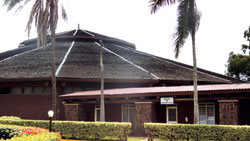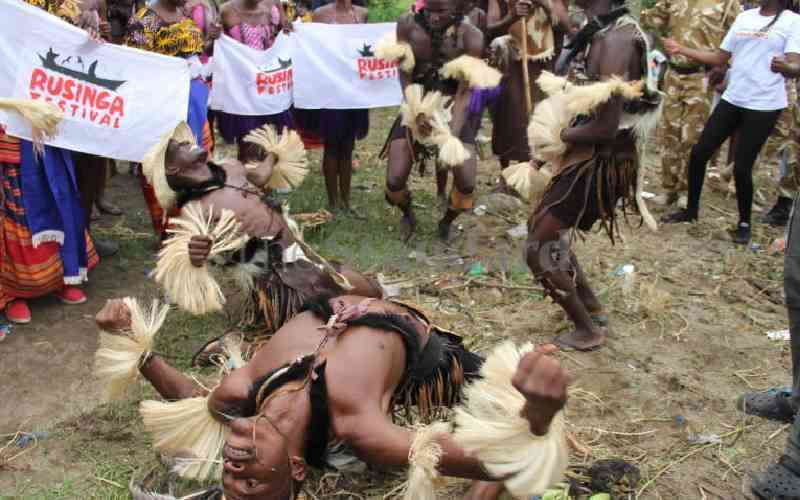The cradle of Kenya’s diverse cultures was mooted soon after independence to preserve our heritage, writes JECKONIA OTIENO
The idea to set up the biggest cultural centre in Kenya was mooted in the early 1960s soon after Independence by James J Mageria and others.
Mageria and company noted that if no organisation was set up to preserve our culture then it could die off with time.?
The government, therefore, decided to set up Bomas of Kenya. The very first step was to come up with the name. Since Kenya is made up of many communities, each having distinct homesteads, the name ‘boma’ was adopted.
Boma means home while its plural bomas stands for many homes; Bomas of Kenya, therefore, simply means homes of Kenya.
After coining the name a company was set up to start work on building and managing the centre.
 |
The Bomas of Kenya amphitheatre.
[PHOTOS: JECKONIA OTIENO / STANDARD ] |
Situated in Langata, the centre is a subsidiary of the Kenya Tourist Development Corporation and it has been around for four decades.
Part of the Bomas of Kenya grounds was actually a cemetery, therefore there had to be a lot of planning and designing in order to set up the centre. The cemetery was moved across the river to creat land for the development of the centre.
The centre was meant to preserve and maintain culture through three main ways, according to Benard Ongeri, an information officer at the centre: Preservation of costumes and artefacts; construction of traditional homesteads and performance of cultural dances.
Cultural cradle
Ongeri notes that research had to be done in different communities in order to establish their true cultures.
From eleven homesteads when the facility was started the number of homesteads has grown to 22.
Ongeri reveals that there are plans to set up a total of 42 homesteads and even more, especially those of communities that are regarded sub-tribes of others.
?Bomas, well known to revellers and cultural enthusiasts alike, is situated outside the city centre with more land for further development.
Did you know that actually until recently most of the gala performances of the Kenya Music Festivals were held at the facility?
Educational institutions would congregate in Nairobi from all over the country to sing and recite their hearts out before selected winners gave fantastic shows at Bomas of Kenya.
However, Bomas of Kenya is not all about performances and entertainment. At the core is the preservation of culture. Weekends are usually busy with cultural dances from 47 communities being showcased at the amphitheatre. This enhances the appreciation of the Kenyan culture and draws audiences from all over. Public holidays are also very busy.
The cultural centre, in a bid to maintain the African roots, has an amphitheatre that is built to resemble an African house.
The auditorium which can accomodate 3, 000 people at one go is the greatest attraction for the facility and also the biggest within the compound.
Ongeri points out that the amphitheatre is round just like the shape of many traditional Kenyan houses.
Popular venue
?Many musicians have used the amphitheatre to showcase their talents, the latest being American R&B singer Joe Thomas who performed there last month.
In tandem with culture, most cultural dances are staged here to preserve the cultural ways from extinction.
??There is more than what might have met any visitor’s eye in the 1980s and 1990s. A visit at Bomas today shows that there is more than just the landmark auditorium or traditional homesteads.
?Under construction are three conference halls all modelled like the main amphitheatre. These are expected to cover the growth of patronage to the facility, which was initially started to preserve the culture of Kenya.
For Kenyans who have never been to their ethnic backgrounds, or have no idea of their roots or what their community homesteads were like, then a visit to Bomas of Kenya will open the doors of cultural knowledge.
Other than just the traditional houses on display, there are also vegetation like trees, shrubs, which have scientific names, attached to them. The bushes surround the homesteads with paths meandering to every homestead.
?Most outstanding, however, are the towering eucalyptus trees probably grown to deal with the sogginess of the place during the rainy seasons.
Not to be left behind is the spacious play area where children can play to avoid boredom, these have been put in place to ensure both adults and children enjoy a visit to Bomas.
The open field also adds to what Bomas has to offer because it allows for team building, games and walks in the grass overlooking the forest on the opposite ridge.
?
Bomas of Kenya is a household name in Nairobi; to many it is just Bomas, a famous matatu stage that is at the junction of Karen, Langata and Magadi roads, but it holds a lot in the history of cultural preservation in Kenya.
Stay informed. Subscribe to our newsletter
 The Standard Group Plc is a
multi-media organization with investments in media platforms spanning newspaper
print operations, television, radio broadcasting, digital and online services. The
Standard Group is recognized as a leading multi-media house in Kenya with a key
influence in matters of national and international interest.
The Standard Group Plc is a
multi-media organization with investments in media platforms spanning newspaper
print operations, television, radio broadcasting, digital and online services. The
Standard Group is recognized as a leading multi-media house in Kenya with a key
influence in matters of national and international interest.
 The Standard Group Plc is a
multi-media organization with investments in media platforms spanning newspaper
print operations, television, radio broadcasting, digital and online services. The
Standard Group is recognized as a leading multi-media house in Kenya with a key
influence in matters of national and international interest.
The Standard Group Plc is a
multi-media organization with investments in media platforms spanning newspaper
print operations, television, radio broadcasting, digital and online services. The
Standard Group is recognized as a leading multi-media house in Kenya with a key
influence in matters of national and international interest.









